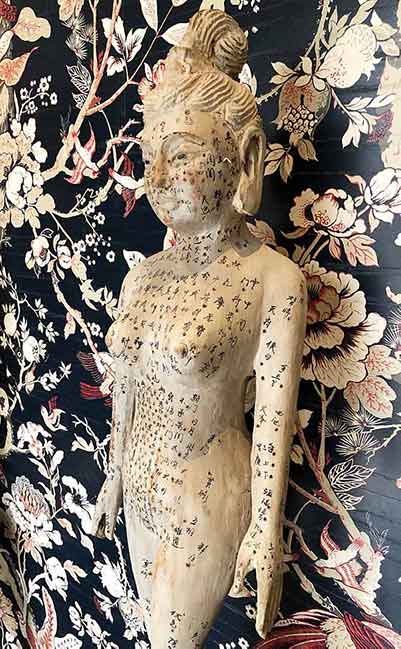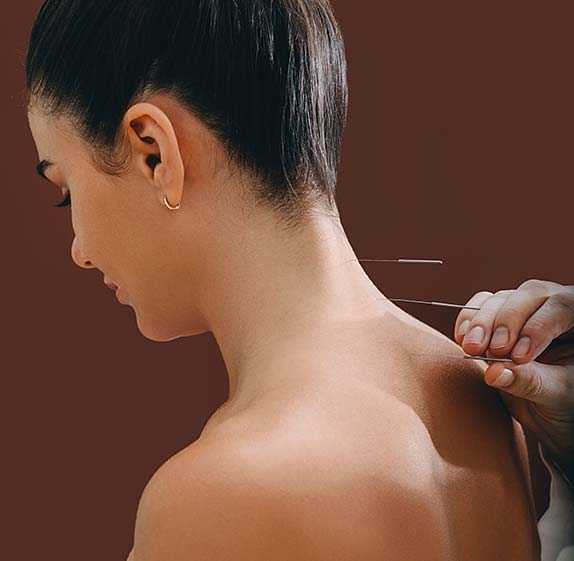- lombalgia
- sciatica
- dolore al ginocchio
- cervicalgia
- periartrite della spalla
- fibromialgia
- insonnia
- stanchezza cronica
- mal di testa
- nevralgia post-herpetica
- depressione
- sindrome da stress
- rinite allergica
- asma bronchiale
- malposizione del feto
- fertilità
- sindrome premestruale e dolori mestruali
- problemi gastrointestinali
Che cos’è l’agopuntura

L'agopuntura è una metodica terapeutica dalla storia millenaria che utilizza piccoli aghi metallici per stimolare specifiche aree del corpo chiamate agopunti. Questa stimolazione induce risposte nell'organismo che coinvolgono diverse strutture e meccanismi che regolano l'omeostasi corporea, il complesso equilibrio interno del nostro corpo.
L'agopuntura è una disciplina della Medicina Tradizionale Cinese (MTC) che sta diventando sempre più accettata nella medicina occidentale grazie all'integrazione e alla complementarietà delle conoscenze delle due discipline.
Le origini
Le origini dell'agopuntura sono incerte, ma si ritiene che risalga ad almeno 2500 anni fa, nella Cina dell'Imperatore Giallo, all'inizio della civiltà e della cultura cinese. Con il passare dei secoli, l'agopuntura si è evoluta fino alla produzione di testi scientifici.
Nel 1500, l'agopuntura ha fatto la sua prima comparsa in Occidente con la traduzione dei testi classici e si è diffusa negli anni '50 fino ad essere approvata dalle nazioni europee e dall'OMS (Organizzazione Mondiale della Sanità). In Italia, l'agopuntura è considerata un atto medico e può essere praticata solo da medici che hanno conseguito un apposito diploma.
Come funziona
L'agopuntura si basa sul principio che l'organismo è composto da energia e che una malattia o disturbo è causato da uno squilibrio di questa energia. L'agopuntore utilizza la terapia per riportare l'equilibrio energetico e riportare l'organismo allo stato di salute.
Secondo la medicina occidentale, gli effetti dell'agopuntura sono numerosi, tra cui la capacità di alleviare il dolore, ridurre l'infiammazione, modulare il sistema immunitario, rilassare i muscoli e migliorare l'umore con effetti antidepressivi e ansiolitici.
L'approccio alla prevenzione e al benessere complessivo della persona
L'agopuntura guarda al benessere complessivo del paziente e tiene conto delle profonde influenze che lo stato mentale ha sulla salute del corpo e viceversa.
L'agopuntura sposta l'attenzione terapeutica dalla malattia al malato, considerando i diversi aspetti della vita del paziente, delle sue abitudini e dei suoi sentimenti. Nata come medicina preventiva nell'antichità, questa pratica riequilibrante è radicata nella medicina tradizionale cinese e, come dice il vecchio detto "prevenire è meglio che curare", l'agopuntura è una metodica terapeutica che può aiutare a prevenire le malattie e migliorare il benessere complessivo della persona.
Come funziona una seduta di agopuntura
Una seduta di agopuntura dura circa un'ora e inizia con un colloquio dettagliato per capire le esigenze del paziente. Il medico effettua un'anamnesi approfondita, indagando su molti aspetti della vita quotidiana del paziente.

Anche se alcune domande potranno sembrare strane e non pertinenti al problema presentato, queste sono fondamentali, e come dei piccoli tasselli di un puzzle sono indispensabili per formare un'immagine che rappresenta la terapia il più possibile aderente alle caratteristiche e alle esigenze del paziente.
Segue poi la visita medica con l'esame obiettivo e in particolare con l'esame della lingua e dei polsi.
Terminata questa fase, inizia la vera e propria terapia con l’infissione degli aghi; il loro numero può variare (tra i 10-15) e anche le zone dove vengono posizionati possono cambiare da trattamento a trattamento e da seduta seduta. Gli aghi sono posizionati di solito a livello di arti, schiena, addome e testa sempre in base alla problematica da trattare. Il paziente sta in una posizione comoda, di solito supino, e gli aghi restano infissi per una ventina di minuti.
Gli aghi sono in acciaio e rame, sterili, monouso e confezionati singolarmente. Si tratta di aghi con la punta smussa, quindi quando vengono infissi non lacerano i tessuti ma li scollano dolcemente senza causare sanguinamento e risultando quasi indolore. Le sensazioni che si possono avvertire sono come una scossa delicata, un pizzicore profondo, calore sotto la pelle; tutte sensazioni che testimoniano l’attivazione dell’energia.
Gli effetti collaterali sono rarissimi e locali, come piccoli ematomi, indolenzimento del punto e lievi irritazioni transitorie.
Il numero di sedute varia dal tipo di problema da trattare, dal paziente e dalla sua risposta, di solito più cronico e di lunga durata è il disturbo più difficile è da trattare, si parla di un minimo di 4-5 sedute fino ad arrivare ad un massimo di 10.
Quali sono le principali indicazioni
L'agopuntura è una metodica terapeutica efficace per trattare diverse malattie e sintomi come:
Gli studi controllati hanno dimostrato l'effetto terapeutico dell'agopuntura in queste condizioni.